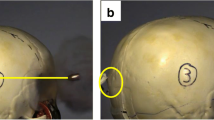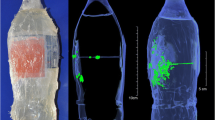Abstract
Traces of backspatter in gun barrels after homicidal or suicidal contact shots may be a valuable source of forensic evidence. Yet, a systematic investigation of the persistence and durability of DNA from biological traces in gun barrels is lacking. Our aim was to generate a realistic model to emulate blood and tissue spatters in gun barrels generated by contact gunshots at biological targets and to analyse the persistence and typability of DNA recovered from such stains. Herein, we devise and evaluate three different models for the emulation of backspatter from contact shots: a gelatine-based model with embedded blood bags, a model based on a spongious matrix soaked with blood and covered with a thin plastic membrane and a head model consisting of an acrylic half sphere filled with ballistic gelatine and with blood bags attached to the sphere under a 3-mm silicone layer. The sampling procedure for all three models: a first shot was fired with several types of guns at each model construction and subsequently a second shot was fired at a backstop. Blood samples were collected after each shot by probing the inner surface of the front and rear end of the respective gun barrel with a sterile swab. DNA was then extracted and quantified and up to 20 different short tandem repeat (STR) systems were amplified to generate DNA profiles. Although DNA quantity and STR typing results were heterogenous between the models, all models succeeded in delivering full STR profiles even after more than one shot. We conclude that biological traces in gun barrels are robust and accessible to forensic analysis and that systematic examination of the inside of gun barrels may be advisable for forensic casework.


Similar content being viewed by others
References
Richert NJ (2011) Swabbing firearms for handler’s DNA. J Forensic Sci 56:972–975
Karger B, Meyer E, Knudsen PJ, Brinkmann B (1996) DNA typing of cellular material on perforating bullets. Int J Legal Med 108:177–179
Karger B, Meyer E, DuChesne A (1997) STR analysis on perforating FMJ bullets and a new VWA variant allele. Int J Legal Med 110:101–103
Dieltjes P, Mieremet R, Zuniga S, Kraaijenbrink T, Pijpe J, de Knijff P (2011) A sensitive method to extract DNA from biological traces present on ammunition for the purpose of genetic profiling. Int J Legal Med 125:597–602
Schyma C (2011) Wounding capacity of muzzle gas pressure. Int J Legal Med. doi:10.1007/s00414-011-0641-y
Bauer M, Polzin S, Patzelt D (2003) Quantification of RNA degradation by semi-quantitative duplex and competitive RT-PCR: a possible indicator of the age of bloodstains? Forensic Sci Int 138:94–103
Anderson S, Howard B, Hobbs GR, Bishop CP (2005) A method for determining the age of a bloodstain. Forensic Sci Int 148:37–45
Kimura A, Ishida Y, Hayashi T, Nosaka M, Kondo T (2011) Estimating time of death based on the biological clock. Int J Legal Med 125:385–391
Taylor MC, Laber TL, Epstein BP, Zamzow DS, Baldwin DP (2011) The effect of firearm muzzle gases on the backspatter of blood. Int J Legal Med 125:617–628
Acknowledgements
We thank all volunteers for providing blood samples. The excellent technical assistance of Marion Sauer is gratefully acknowledged.
Declaration
We hereby declare that all blood samples have been provided by consenting and informed volunteers and that all experiments performed in this study comply with the current German laws.
Author information
Authors and Affiliations
Corresponding author
Rights and permissions
About this article
Cite this article
Courts, C., Madea, B. & Schyma, C. Persistence of biological traces in gun barrels—an approach to an experimental model. Int J Legal Med 126, 391–397 (2012). https://doi.org/10.1007/s00414-011-0655-5
Received:
Accepted:
Published:
Issue Date:
DOI: https://doi.org/10.1007/s00414-011-0655-5




